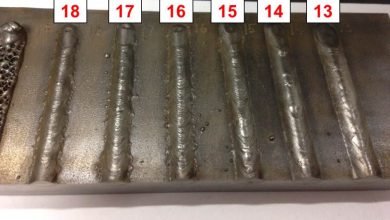How to Check Welding Penetration
To check welding penetration, ultrasonic testing (UT) is a nondestructive method that can be used.
Portable weld penetration test equipment, such as Zetec’s TOPAZ family of instruments and the WELD Crawler, are now available for field testing.
This equipment is useful in industries like petroleum pipelines and refineries.
By using UT, these devices can detect flaws such as lack of penetration and crack formation.
Based on the test results, corrective measures can be taken.
Weld penetration refers to the depth of fusion during welding and is influenced by the welding current.
Increasing the welding current increases weld penetration, while decreasing it decreases weld penetration.
Therefore, checking welding penetration involves using UT equipment and examining the depth of fusion in the weld joint.
Check this out:
Did You Know?
1. Welding penetration refers to the depth of fusion between the base metal and the filler material in a weld joint.
2. To check welding penetration, one method involves cutting through the weld bead and examining the cross-section.
3. A lack of proper welding penetration can weaken the joint and compromise its integrity.
4. Magnetic particle inspection is a nondestructive testing method commonly used to detect irregularities in welding penetration.
5. The American Welding Society provides guidelines and standards for checking welding penetration to ensure the quality and safety of welded structures.
Introduction To Ultrasonic Testing For Welding Penetration
Ultrasonic testing (UT) is a nondestructive method used to check welding penetration. This technique is highly valuable in assessing the quality and strength of welds in various industries. By using ultrasonic waves, flaws such as lack of penetration and crack formation can be detected, allowing for corrective measures to be taken based on the test results.
Welding penetration refers to the depth of fusion during the welding process. It plays a crucial role in determining the overall strength and integrity of a weld joint. Deeper penetration can be both beneficial and problematic, depending on the application.
To assess welding penetration, portable weld penetration test equipment has been developed, making field testing a viable option. This is particularly useful in industries like petroleum pipelines and refineries, where welding quality and integrity are critical.
Portable Equipment For Field Testing Of Weld Penetration
In recent years, there have been significant advancements in technology that have made portable weld penetration test equipment available. This equipment has revolutionized the way welding penetration is checked by enabling technicians to perform on-site inspections. This has reduced the dependence on lengthy laboratory testing and expedited the decision-making process.
The key benefits of portable weld penetration test equipment include:
- Real-time evaluation: Technicians can now assess welding penetration immediately, allowing for prompt action when required.
- On-site inspections: The ability to perform inspections at the welding site eliminates the need for transporting samples to laboratories, saving time and resources.
- Expedited decision-making: With portable equipment, decisions regarding the quality of weld penetration can be made quickly, leading to faster project completion.
In this context, it is worth mentioning a pertinent quote:
“The availability of portable weld penetration test equipment has transformed the welding industry, enabling efficient on-site inspections and quicker decision-making.” – Welding expert
Overall, the development of portable weld penetration test equipment has significantly improved the efficiency and effectiveness of evaluating weld penetration. Its real-time evaluation capability, on-site inspections, and faster decision-making have brought about a positive change in the industry.
Applications Of Portable Weld Penetration Test Equipment
The applications for portable weld penetration test equipment are diverse and extensive. Various industries, such as oil and gas, power generation, and manufacturing, rely on welding for different purposes.
Portable equipment can be used in these industries to evaluate weld penetration in critical structural components, pipelines, storage tanks, and other welded assemblies.
In the petroleum industry, for example, the ability to assess weld penetration in pipelines is essential to ensure the structural integrity and safety of these vital assets. By utilizing portable weld penetration test equipment, technicians can identify potential flaws, such as lack of penetration or cracks, and take the necessary measures to rectify them.
- Portable weld penetration test equipment is crucial in various industries.
- It helps evaluate weld penetration in critical components.
- The petroleum industry relies on this equipment to ensure the structural integrity and safety of pipelines.
“The ability to assess weld penetration in pipelines is essential to ensure the structural integrity and safety of these vital assets.”
Examples Of Portable Weld Penetration Test Equipment
Zetec, a leading provider of nondestructive testing solutions, offers a range of ultrasonic testing technologies for weld quality inspection. Their TOPAZ family of instruments and the WELD Crawler are notable examples of portable weld penetration test equipment. These devices feature advanced software and hardware capabilities, allowing technicians to conduct comprehensive inspections and obtain accurate results.
The TOPAZ family of instruments offers portable UT solutions with exceptional capabilities for weld penetration testing. They provide high-resolution imaging, detailed analysis, and precise flaw detection, ensuring accurate assessments of welding quality. On the other hand, the WELD Crawler is a versatile and robust solution designed for inspecting large-diameter pipes and vessels. Its automated scanning capabilities reduce inspection time and improve accuracy, enabling efficient evaluation of weld penetration.
Detection Of Flaws And Corrective Measures With Weld Penetration Testing
Through ultrasonic testing for weld penetration, flaws such as lack of penetration and crack formation can be detected. This valuable information allows corrective measures to be implemented promptly. Depending on the specific flaw, corrective measures might include adjusting welding parameters, modifying the welding technique, or reworking the weld.
For example, if lack of penetration is detected, increasing the welding current may be necessary. Weld penetration is influenced by the welding current, with higher currents resulting in deeper penetration. Conversely, decreasing the welding current will decrease weld penetration. It is essential to strike a balance to achieve the optimal level of penetration for the intended application.
Zetec’s Ultrasonic Testing Technologies For Weld Quality Inspection
Zetec offers a comprehensive range of ultrasonic testing technologies for weld quality inspection. Their solutions ensure accurate and reliable evaluation of weld penetration, assisting in maintaining the integrity and safety of critical welds. By utilizing Zetec’s cutting-edge equipment, technicians can make informed decisions based on precise, real-time data.
Ultrasonic testing has proven to be an effective nondestructive method to check welding penetration. Portable weld penetration test equipment has revolutionized the field by providing real-time assessment capabilities. By relying on advanced technologies such as Zetec’s TOPAZ family of instruments and the WELD Crawler, technicians can detect flaws and take corrective measures promptly. This level of accuracy and efficiency ensures the quality and durability of welds in various industries, contributing to safer and more reliable structures and systems.
Frequently Asked Questions
How do you ensure weld penetration?
To ensure proper weld penetration, it is crucial to maintain a travel angle between 0° to 10°. This angle allows the electrode to be perpendicular or mostly perpendicular to the plate, directing the arc force downward into the base plate. It is this direct force that facilitates enhanced weld penetration. By consistently monitoring and adjusting the travel angle, welders can achieve the desired level of penetration and ensure a strong, reliable weld.
How do you check for lack of penetration in welding?
To ensure that there is no lack of penetration in welding, various inspection methods can be employed. While a visual inspection is effective in identifying surface defects, it may not reveal issues with penetration inside the weld. Therefore, X-ray or ultrasonic inspection techniques are the preferred methods to detect lack of penetration. By utilizing these methods, any potential flaws or incomplete fusion within the weld can be identified, allowing for necessary corrections or adjustments to ensure the quality and integrity of the weld joint.
What chemical is used to check welding penetration?
To check welding penetration, a commonly used chemical is ferric chloride. This chemical is chosen for its ability to selectively react with the base material of the weld joint, highlighting the extent of penetration. When applied to the cross-section of the weld, ferric chloride causes a distinct color change that visually signifies the depth and quality of the penetration. This simple yet effective technique provides valuable insight into the integrity of the weld joint.
What causes of poor penetration?
Poor penetration can arise from a variety of factors. One potential cause is inadequate joint preparation, where the surface is not properly cleaned or shaped before welding. This can result in a lack of fusion between the two materials, leading to weak and unreliable welds. Another factor contributing to poor penetration is the use of incorrect materials or techniques. Incompatible materials or improper welding procedures can inhibit the flow of heat and hinder the formation of strong bonds. Additionally, suboptimal operating conditions, such as inappropriate temperature or pressure, can negatively impact penetration. Ensuring thorough joint preparation, using appropriate materials and techniques, and maintaining optimal operating conditions are crucial steps to prevent poor penetration and ensure sound welds.

